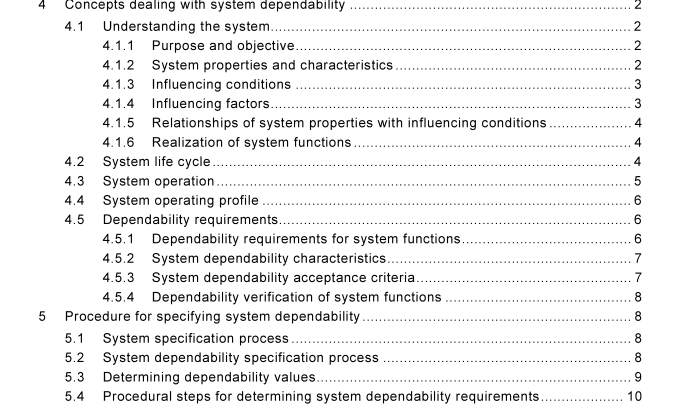AS IEC 62347:2008 pdf download – Guidance on system dependability specifications
4 Concepts dealing with system dependability
4.1 Understanding the system
4.1.1 Purpose and objective A system is designed for a purpose. A system must have a defined objective to achieve its purpose. The purpose of a home theatre system is to provide cinema-like entertainment in a home environment. The objectives may include users’ perception of a clear picture vision and superb sound quality, reliability and safety in operation, and ease of installation and upgrade. A system may have a specific objective to perform a dedicated task, such as an aircraft carrying cargo to reach a delivery target. The objectives of a system may include the com- pletion of a sequence of tasks, such as delivering different payloads to different destinations. Defining the system to meet its generic or specific objectives is an important prerequisite of specifying the system requirements. A system with multiple functions and complex operating scenario often involves external interacting systems to achieve its objectives. A system may also evolve with time, resulting from enhancements of its performance capability, to sustain service demands in operation and for market competition.
4.1.2 System properties and characteristics A system has a set of properties specifically assigned, selected or designed into the system to meet its intended objectives. Specific system properties are used to develop the needed functions to perform the tasks. These properties represent the special features or attributes inherent in the system. They may be categorized in major groupings as defined in IEC 61 069 series. Under each group is a set of characteristics relevant to and dominant in that group. The functions are derived from those system properties by means of interacting elements within the system. The interacting elements are designed to provide specific characteristics capable of delivering the system functions and to carry out the tasks once these functions can be realized. System characteristics may be qualitative or quantitative. Figure 1 shows an example of the system characteristics grouped under various system properties.
4.1.3 Influencing conditions In order to determine which functions have the selected characteristics appropriate to achieving a specific objective, it is necessary to define the conditions that the system is capable of withstanding or meeting the demands and duration of the assigned tasks. The following areas of influence or domains affecting the system should be considered:
• task requirements imposed on the system;
• human interface with the system;
• process involved with system operation;
• environment to which the system is exposed;
• support services available for the system;
• utilities needed to operate the system;
• external interacting systems;
• constraints and regulations.
A system dependability specification cannot be completed in isolation. It requires the input of detailed information at the system planning stage to determine how the system is intended to perform for the entire duration of its defined life. This effort is essential to permit identification and selection of dependability and other relevant characteristics, and justification for design trade-off and system optimization.
4.1.4 Influencing factors Each influencing condition can be affected by various factors influencing the status of its condition. For example, the task requirements imposed on the system could be influenced by factors associated with the nature and duration of the task; the system environment could be influenced by the temperature and humidity of the system ambience. Influencing factors are not equal to the extent of their influence. Some factors are more prominent or dominant in the extent of their influence while others may have less influence or be negligible. Annex A provides typical examples of influencing factors on system functions to serve as criteria for evaluation of system dependability characteristics.
4.1.5 Relationships of system properties with influencing conditions Establishing the relationships of system properties with influencing conditions can help identify the relevance and criticality of a specific external condition influencing the design of a function. The identification process will lead to the selection of specific properties and associated characteristics that are needed for the function. The selected characteristics are not exclusive to a specific function. The same characteristics may be needed in the design of other functions. The importance of these characteristics is determined by an iterative process for evaluation and design trade-off. The results derived from this evaluation can help determine the system configuration and establish the appropriate system boundaries in meeting the intended objective. The relevant information and data captured in this evaluation process will form the basis for specifying the important characteristics in the design of system functions.
